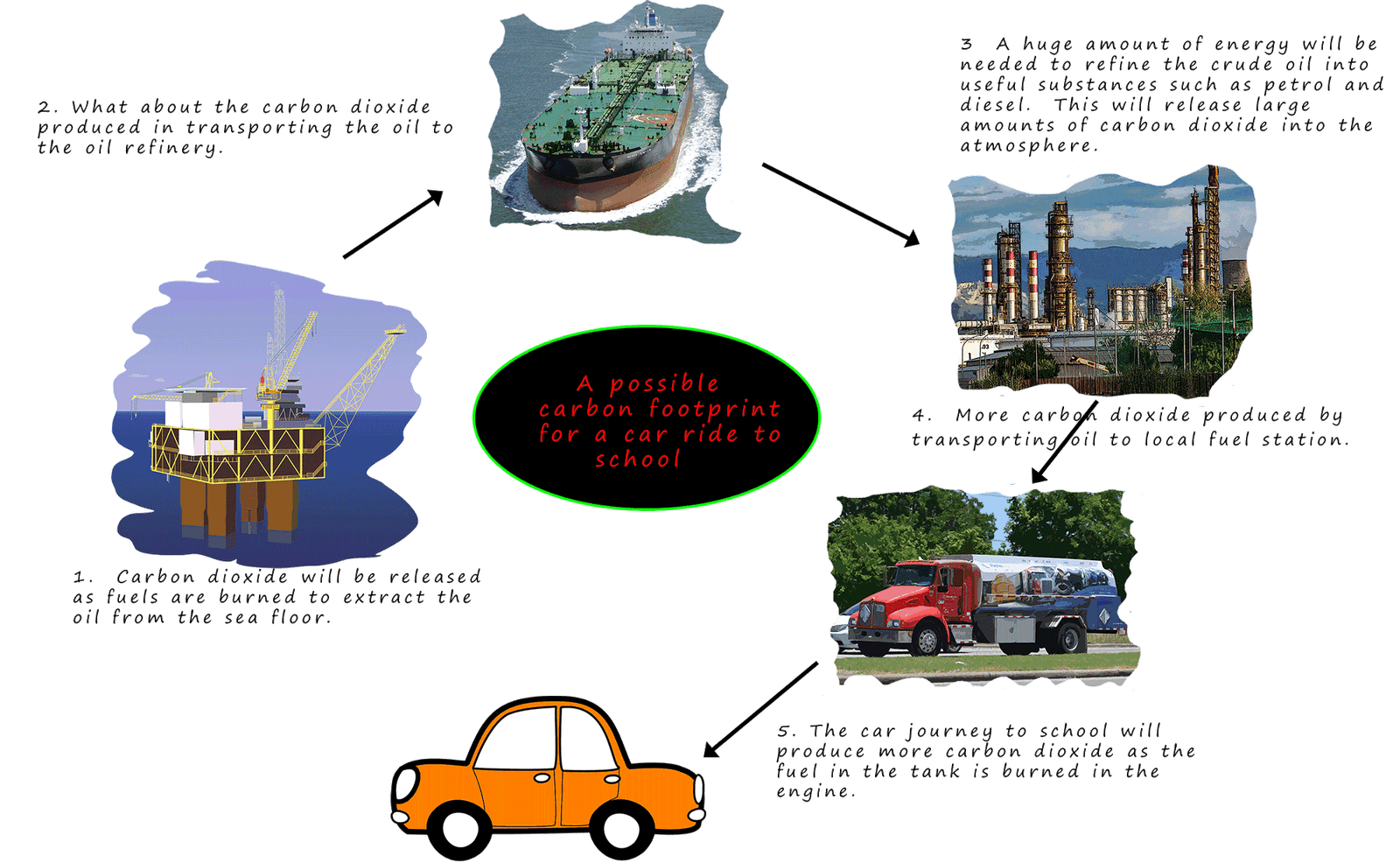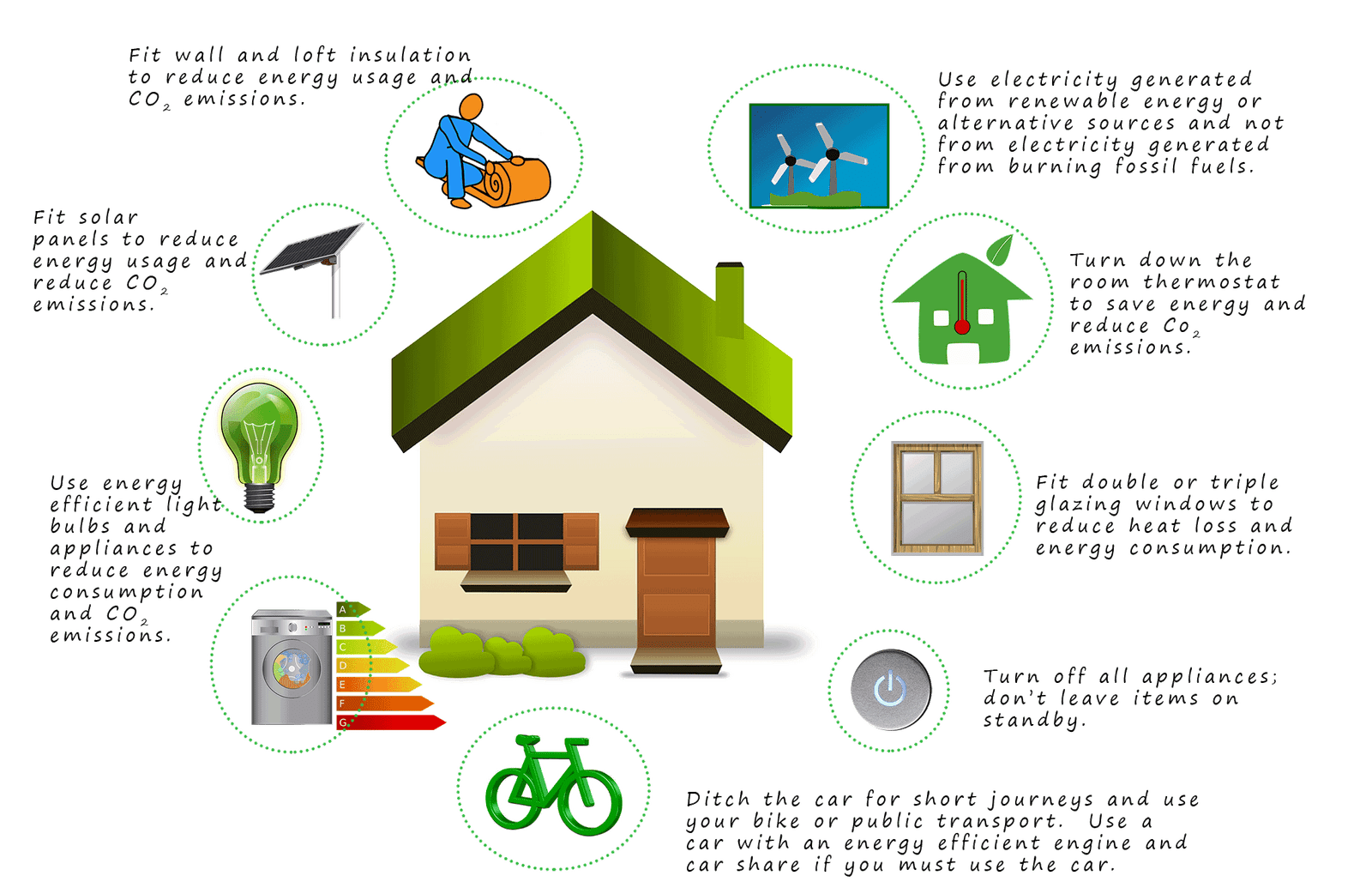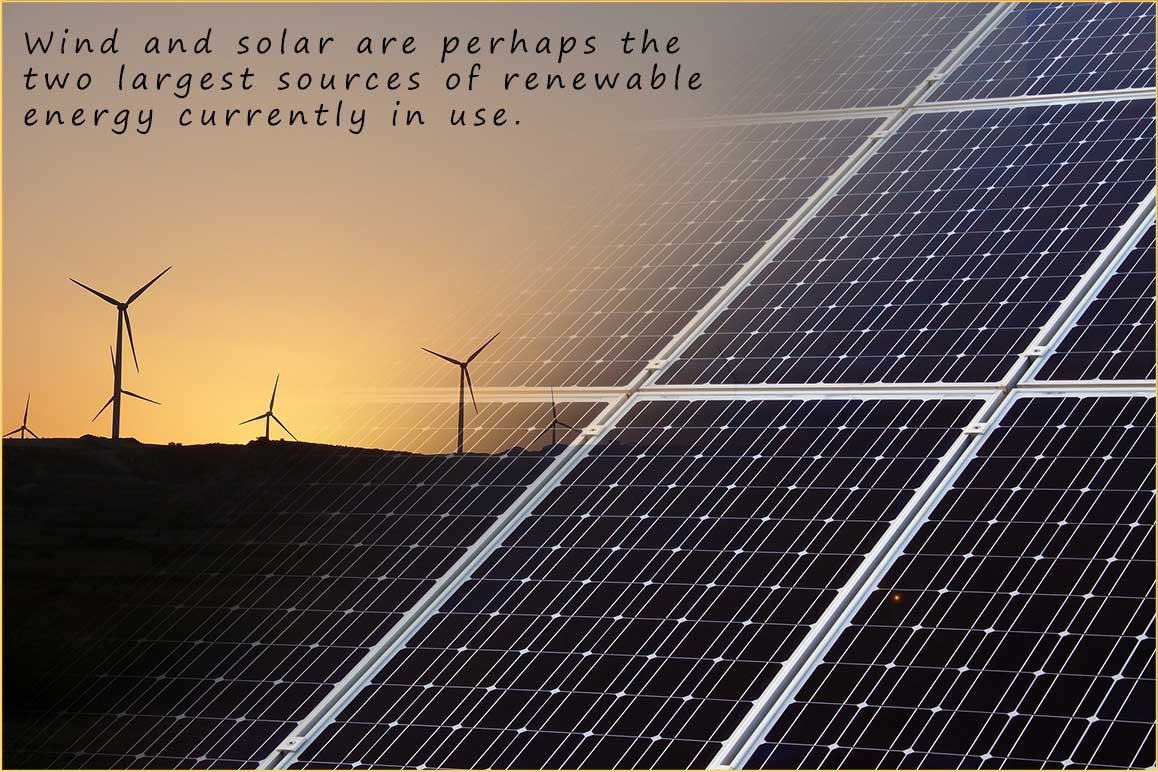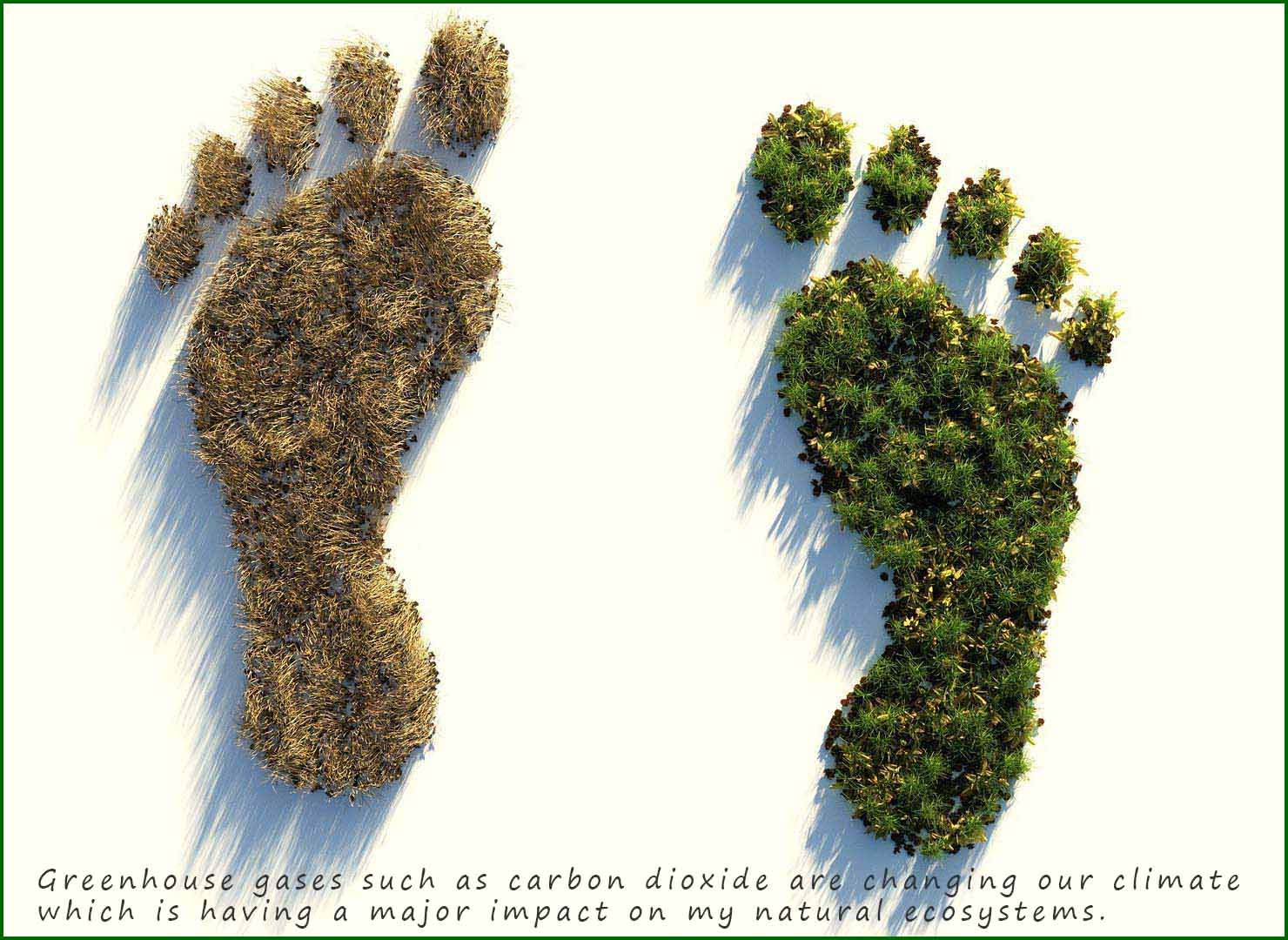Higher and foundation tiers
Carbon footprint
The
carbon footprint is the total amount of carbon dioxide and other greenhouse gases
produced as a result of a
particular organisation or individual carrying out a task or making an item or providing a service. For example
taking the bus to school results in the bus burning a fossil fuel; diesel which releases CO2 into the atmosphere. The school will also have its own
carbon footprint; it will use electricity and gas to provide heat, light and to run all the computers and other appliances in the school buildings; all of these activities ultimately release CO2. Most of the teachers in the school
will have driven a car to school; which will burn petrol or diesel which also releases CO2 into the atmosphere.
Calculating the amount of carbon emitted by some event is not always as easy as you might imagine. Consider your journey
to school. Let's assume you get a lift in your parents car.
You might assume then that the only carbon released into the atmosphere is from the carbon dioxide produced by burning the fuel in
the car. However think about all the activities that have to be gone through in order to get the petrol/diesel for the
car into the local fuel station and all the carbon dioxide released in manufacturing the car in the first place. The image below gives some detail of the carbon footprint for a simple car journey to school.
The carbon footprint for a car journey to school

And of course don't forget all the carbon dioxide produced in actually manufacturing the car and all its components
and transporting all these to the factory where the car is assembled and then disposing of it when the car reaches the end
of its life. So perhaps it is easy to see that the carbon footprint is probably much larger than most people imagine; even for a simple event such as a car journey.
Now consider all the items and activities that you do in say one week and think about all the pollution and
carbon dioxide that has been added to the atmosphere to enable you have these things and do all those activities.
Although it may prove difficult to calculate the your total carbon footprint but there are a number of things that as
individuals we can do to reduce our carbon footprint e.g.

- Use energy generated from renewable energy sources and alternative energy resources such as:
- solar panels.
- wind turbines.
- nuclear power.
- Increase the energy efficiency of our homes and work places and maximise the energy efficiency of all appliances that we use.
- Use loft and cavity wall insulation to reduce energy consumption and so reduce your carbon footprint.
- Use appliances with high energy efficiency rating e.g. swap all light bulbs for LED bulbs.
- Do not leave appliances on standby but instead switch them off at the wall when they are not in use.
- Use public transport and reduce the use of cars and airplanes. Walk or use a bike for all short journeys.
How to reduce your carbon footprint
The diagram below summaries the main points from above and offers some helpful hints on how to reduce your carbon footprint at home.

- Improving the insulation in our homes will allow you to turn down the heating thermostat and so burn less gas/use
less electricity.
- Turn off appliances when they are not in use. Do not leave items on stand-by mode and use energy efficient appliances
and devices. Not only will this reduce emissions of carbon dioxide but also it will save you money!
- Use your bike for short journeys and public transport for longer ones. This will reduce your CO2 emissions.
- Only buy food produced locally and buy seasonal food. Do you need apples from New Zealand when English apples are just as good?
- Avoid single use plastic, paper and glass products. Recycle as much as you can. Not only will this save on CO2
emissions from manufacturing replacement products and transport to landfill but it will also reduce emissions of methane as waste material rots in the ground.
- Compost all organic waste.

The role of big business and governments
There are also many things that can be done by organisations and governments to reduce the carbon foot print of the U.K. These include:
- Burn less fossil fuels in power station by using more renewable energy sources such as wind, wave and solar to
generate electricity.
- Use nuclear fuels to generate electricity. These produce no CO2
- Tax car owners to encourage them to buy smaller more fuel efficient cars or provide financial incentives to switch
to electric vehicles.
- Increase the amount of biofuels in petrol, currently petrol contains 10% alcohol made from biofuels.
- Invest in carbon capture and storage (CSS); here the carbon dioxide produced by burning coal and oil to generate
electricity is trapped before it enters the atmosphere and is stored underground in disused mines and oil wells.
However CSS is very expensive, so a choice needs to be made.
Carbon reduction

The actions listed above can all be completed by individuals and governments to try and reduce their carbon footprint; however to truly have an impact and reduce total global emissions of carbon dioxide and other greenhouse gases really needs to involvement of governments and international organisations to set goals and targets such as those set at the COP conferences e.g.
- Carbon off setting- This is where action is taken to compensate for carbon dioxide emissions from industrial or other human activity; by taking part in schemes designed to make equivalent reductions of carbon dioxide in the atmosphere elsewhere; this can be done locally and internationally for example this may include
- Planting more tress and help with reforestation.
- Investing in renewable energy sources such as wave power or wind farms.
- Investing in technologies which will reduce the emissions of greenhouse gases into the atmosphere.
- Increase the tax on the use of fossil fuels such as petrol and diesel. Making these fuels more expensive will encourage the use of electric vehicles and the investment in renewable less polluting technologies.
- The government can also increase incentives for the use of more carbon neutral fuels such ethanol made from fermenting crops and biofuels made from vegetable oils. These fuels are described as carbon neutral since they release no more carbon dioxide into the atmosphere when they are burned than was removed by the crops when they were growing.
Limited action
 Despite the climate emergency which many scientists believe we are experiencing now action to reduce global emissions
of carbon dioxide, methane and other greenhouse gases are not always very successful with many governments failing to meet their targets for
reductions. The reason for this are varied and many but include:
Despite the climate emergency which many scientists believe we are experiencing now action to reduce global emissions
of carbon dioxide, methane and other greenhouse gases are not always very successful with many governments failing to meet their targets for
reductions. The reason for this are varied and many but include:
- Many governments simply cannot agree on what needs to be done, by when it needs to be completed by and by how much individual countries need to reduce
their carbon emissions.
- The cost of using renewable energy resources can be expensive when compared to that of the traditional fossil fuels. Although the
cost of renewables is dropping all the time as more countries start to use this technology.
- Many governments are concerned that making many of the required changes will affect the economy and economic growth
which could lead to people losing their jobs and livelihoods; especially when not all governments across the globe agree to cut their
carbon emissions as much as many scientists and environmentalist would like.
- Restrictions on carbon emissions will affect developing countries more since they have less money to develop new
technologies.
- People are unwilling to make changes to their lifestyle due to lack of education on the subject. Perhaps the
government needs to make people more aware of the issues that increased carbon emissions will cause in the future and why
people need to make changes to their lifestyles now.
- Governments have been unable to reduce the amount of deforestation taking place globally. Mainly this is due to
economic reasons with some countries eager to take advantage of the money available from deforestation.
Practice questions
Next


 The
carbon footprint is the total amount of carbon dioxide and other greenhouse gases
produced as a result of a
particular organisation or individual carrying out a task or making an item or providing a service. For example
taking the bus to school results in the bus burning a fossil fuel; diesel which releases CO2 into the atmosphere. The school will also have its own
carbon footprint; it will use electricity and gas to provide heat, light and to run all the computers and other appliances in the school buildings; all of these activities ultimately release CO2. Most of the teachers in the school
will have driven a car to school; which will burn petrol or diesel which also releases CO2 into the atmosphere.
The
carbon footprint is the total amount of carbon dioxide and other greenhouse gases
produced as a result of a
particular organisation or individual carrying out a task or making an item or providing a service. For example
taking the bus to school results in the bus burning a fossil fuel; diesel which releases CO2 into the atmosphere. The school will also have its own
carbon footprint; it will use electricity and gas to provide heat, light and to run all the computers and other appliances in the school buildings; all of these activities ultimately release CO2. Most of the teachers in the school
will have driven a car to school; which will burn petrol or diesel which also releases CO2 into the atmosphere.




 Despite the climate emergency which many scientists believe we are experiencing now action to reduce global emissions
of carbon dioxide, methane and other greenhouse gases are not always very successful with many governments failing to meet their targets for
reductions. The reason for this are varied and many but include:
Despite the climate emergency which many scientists believe we are experiencing now action to reduce global emissions
of carbon dioxide, methane and other greenhouse gases are not always very successful with many governments failing to meet their targets for
reductions. The reason for this are varied and many but include: